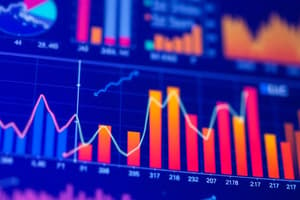Podcast
Questions and Answers
What is a characteristic of nonprobability samples?
What is a characteristic of nonprobability samples?
- Samples can only be taken from large populations.
- All members have an equal chance of being selected.
- Members are selected using methods like convenience or judgment sampling. (correct)
- Members are selected randomly from the population.
Which sampling method involves selecting members who are most accessible?
Which sampling method involves selecting members who are most accessible?
- Systematic Random Sampling
- Convenience Sampling (correct)
- Cluster Sampling
- Stratified Random Sampling
What distinguishes simple random sampling from other sampling methods?
What distinguishes simple random sampling from other sampling methods?
- It selects from a specific subgroup of the population.
- It uses subjective judgment in member selection.
- It gives every member an equal and known chance of being selected. (correct)
- It is always biased toward larger groups.
Which of the following is a method of probability sampling?
Which of the following is a method of probability sampling?
What does multistage sampling involve?
What does multistage sampling involve?
What does a smaller N in forecasting result in?
What does a smaller N in forecasting result in?
How is the forecast error calculated?
How is the forecast error calculated?
What does the tracking signal measure?
What does the tracking signal measure?
Which of the following is a method of probability sampling?
Which of the following is a method of probability sampling?
What is the formula for the weighted moving average forecasting?
What is the formula for the weighted moving average forecasting?
What does Mean Absolute Deviation (MAD) provide a measure of?
What does Mean Absolute Deviation (MAD) provide a measure of?
Which of these statements about a population is accurate?
Which of these statements about a population is accurate?
What does the Mean Square Error (MSE) do?
What does the Mean Square Error (MSE) do?
What type of data is characterized by values that can take any number within a range?
What type of data is characterized by values that can take any number within a range?
Which of the following is NOT a common characteristic of forecasting?
Which of the following is NOT a common characteristic of forecasting?
In the context of time series data, what does the term 'seasonality' refer to?
In the context of time series data, what does the term 'seasonality' refer to?
Which forecasting method relies solely on the last period's actual data?
Which forecasting method relies solely on the last period's actual data?
What is the first step in the forecasting process?
What is the first step in the forecasting process?
Which of the following forecasting models generates forecasts through mathematical modeling?
Which of the following forecasting models generates forecasts through mathematical modeling?
What does the variance measure in statistics?
What does the variance measure in statistics?
Which of the following is a statistical forecasting model method?
Which of the following is a statistical forecasting model method?
Flashcards
Statistical Forecasting
Statistical Forecasting
Forecasting using mathematical modeling and historical data.
Qualitative Forecasting
Qualitative Forecasting
Forecasting based on expert opinions and subjective judgment.
Time Series Data
Time Series Data
Data collected over a period of time, like daily sales.
Naïve Forecasting
Naïve Forecasting
Signup and view all the flashcards
Simple Average (Mean)
Simple Average (Mean)
Signup and view all the flashcards
Forecast Accuracy
Forecast Accuracy
Signup and view all the flashcards
Dependent Variable
Dependent Variable
Signup and view all the flashcards
Independent Variable
Independent Variable
Signup and view all the flashcards
Correlation
Correlation
Signup and view all the flashcards
Discrete Data
Discrete Data
Signup and view all the flashcards
Continuous Data
Continuous Data
Signup and view all the flashcards
Categorical Data
Categorical Data
Signup and view all the flashcards
Moving Average Forecast
Moving Average Forecast
Signup and view all the flashcards
Weighted Moving Average
Weighted Moving Average
Signup and view all the flashcards
Forecast Error
Forecast Error
Signup and view all the flashcards
Mean Absolute Deviation (MAD)
Mean Absolute Deviation (MAD)
Signup and view all the flashcards
Mean Squared Error (MSE)
Mean Squared Error (MSE)
Signup and view all the flashcards
Tracking Signal (TS)
Tracking Signal (TS)
Signup and view all the flashcards
Population
Population
Signup and view all the flashcards
Sample
Sample
Signup and view all the flashcards
Probability Sample
Probability Sample
Signup and view all the flashcards
Nonprobability Sampling
Nonprobability Sampling
Signup and view all the flashcards
Convenience Sampling
Convenience Sampling
Signup and view all the flashcards
Judgment Sampling
Judgment Sampling
Signup and view all the flashcards
Quota Sampling
Quota Sampling
Signup and view all the flashcards
Snowball Sampling
Snowball Sampling
Signup and view all the flashcards
Simple Random Sampling
Simple Random Sampling
Signup and view all the flashcards
Systematic Random Sampling
Systematic Random Sampling
Signup and view all the flashcards
Stratified Random Sampling
Stratified Random Sampling
Signup and view all the flashcards
Cluster Sampling
Cluster Sampling
Signup and view all the flashcards
Multistage Sampling
Multistage Sampling
Signup and view all the flashcards
Multiphase Sampling
Multiphase Sampling
Signup and view all the flashcards
Study Notes
SAKSHAM: IL6 Webinar for Logistics
- This webinar focused on forecasting and sampling techniques.
Basics of Statistics
- Types of Data:
- Numerical (discrete and continuous)
- Categorical (nominal and ordinal)
- Descriptive Statistics:
- Mean, median, mode
- Variance, standard deviation
- Dependent and independent variables
- Correlation
Forecasting Needs
- Crucial decisions requiring forecasts:
- Market selection
- Product planning
- Hiring needs
- Purchases
- Production volumes
Forecasting Characteristics
- Forecasts are often imperfect.
- Aggregate data tends to be more accurate than individual item data.
- Forecasts tend to be more accurate for shorter time periods.
Forecasting Steps
- Define what needs forecasting.
- Detail level, analysis units, time horizon
- Identify and assess available data.
- Select and evaluate a forecasting model.
- Cost, ease of use, and accuracy
- Generate the forecast.
- Track forecast accuracy over time.
Forecasting Models
- Qualitative:
- Subjective forecasts, generated by the forecaster
- Quantitative (Statistical):
- Mathematical models generate the forecasts
Qualitative Forecasting Models
- Executive Opinion:
- Managers meet and collaborate to produce a forecast.
- Strengths: good for strategic or new product forecasting
- Weaknesses: single person's opinion can dominate
- Market Research:
- Surveys and interviews to understand customer preferences.
- Strengths: good for understanding customer preferences
- Weaknesses: can be difficult to create a good questionnaire
- Delphi Method:
- Develop a consensus among a group of experts.
- Strengths: great for long term product forecasting, technological changes, and advances.
- Weaknesses: time consuming to develop
Statistical Forecasting Models
- Time Series Models:
- Assumes future patterns follow past patterns and uses past trends.
- Includes: single variable models, machine learning models
- Causal Models:
- Explores cause-and-effect relationships.
- Uses indicators to predict the future, such as independent/feature variables.
- Examples include price predictions and appliance sales.
Time Series Data Composition
- Data is a combination of historic patterns and random variation.
- Historic pattern may include:
- Level (long-term average)
- Trend (long-term movement)
- Seasonality (regular repeating patterns)
- Cycle (repeating fluctuations)
Time Series Patterns
- Level (Horizontal): Data is relatively constant around a mean.
- Trend: Data is progressively increasing or decreasing.
- Seasonality: Repeating pattern within a defined time period (e.g., quarters).
- Cycle: Fluctuation over longer periods.
Level Forecasting Methods
- Naïve
- Simple Mean
- Moving Average
- Weighted Moving Average
- Exponential Smoothing
Sampling Techniques
- Population: A collection for which an inference is made.
- Sampling Units: Nonoverlapping selections of the population that covers the entire population.
- Probability Sampling:
- Each member has a known chance of being selected.
- Includes random, systematic, and stratified sampling
- Non-Probability Sampling:
- Members selected non-randomly.
- Includes convenience, judgment, quota, and snowball sampling
Sampling for populations
- Study Population: Set of people from the population to be studied.
- Defined characteristics (e.g., age, location).
- Target Population: The larger group an inference or conclusion will be drawn from.
Simple Random Sampling
- Each member has an equal chance of being selected from the population.
Systematic Random Sampling
- Every Nth member from a list is selected.
Stratified Random Sampling
- Population divided into strata (subgroups).
- Random samples from each stratum.
Cluster Sampling
- Population divided into clusters.
- Random selection of clusters.
- All members of selected clusters are examined.
Multistage Sampling
- Multiple stages of random sampling
- Useful when a complete list is unavailable
- Costs are potentially lower, or sampling is more efficient.
Multiphase Sampling
- Collecting information from the whole sample in stages (different information per stage).
Convenience Sampling
- Using readily available participants.
- Non-probability method.
Judgment or Purposive Sampling
- Subjectively chosen respondents.
- Non-probability method.
Quota Sampling
- Segmenting population into groups representing proportions in the population.
- Convenience sampling used to select the required numbers in each stratum.
- Non-probability method.
Snowball Sampling
- Finding participants in a potentially hard-to-reach population using referrals.
- Non-probability method.
Forecast Accuracy
- Error: Difference between the actual value and the forecast value
- MAD (Mean Absolute Deviation): Average absolute forecasting errors.
- MSE (Mean Square Error): Measures the average squared difference between forecasted and observed values.
- Tracking Signal: Tracks data over time to identify forecasting issues
Studying That Suits You
Use AI to generate personalized quizzes and flashcards to suit your learning preferences.




